
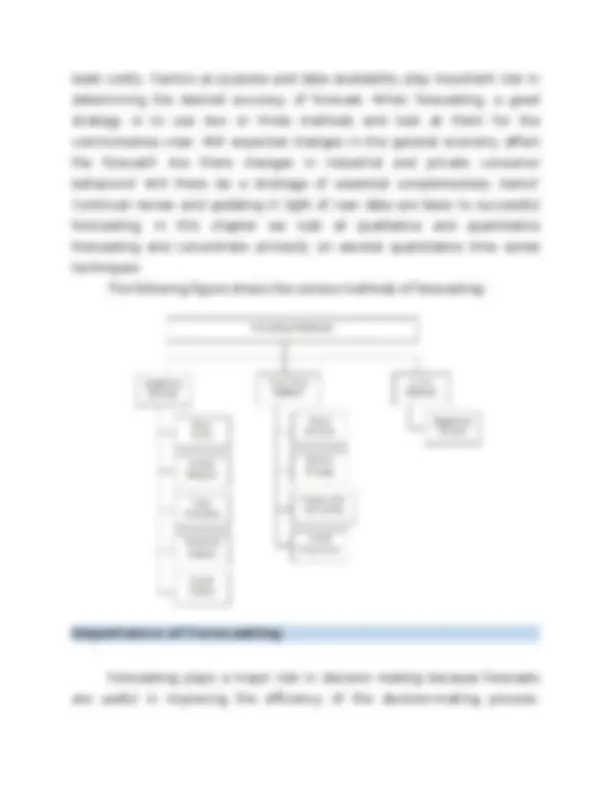
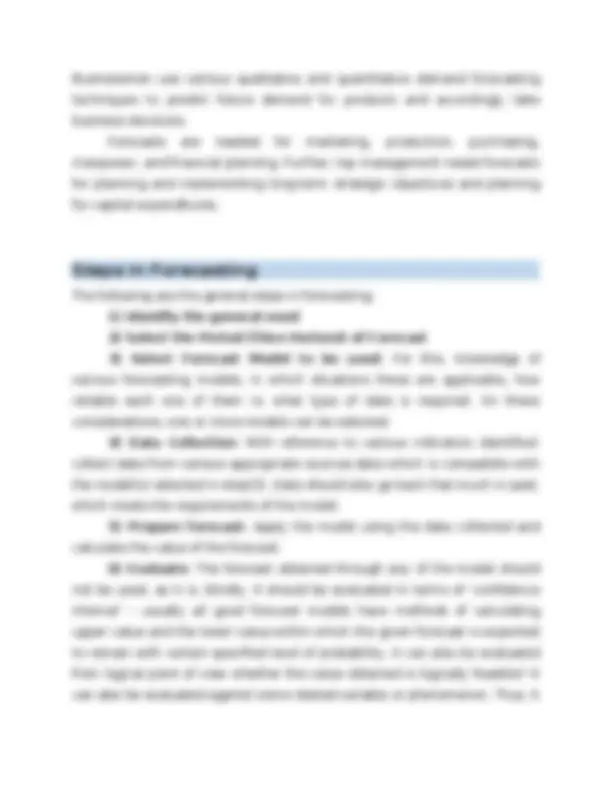
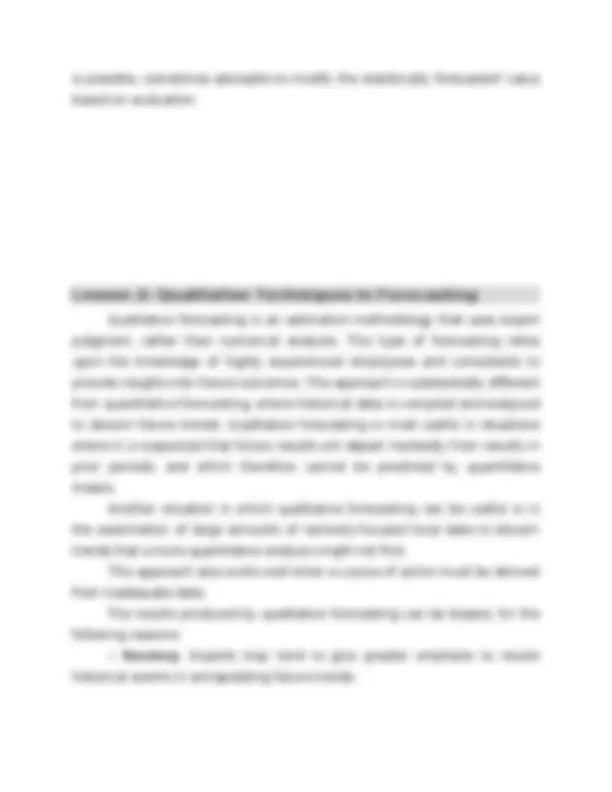
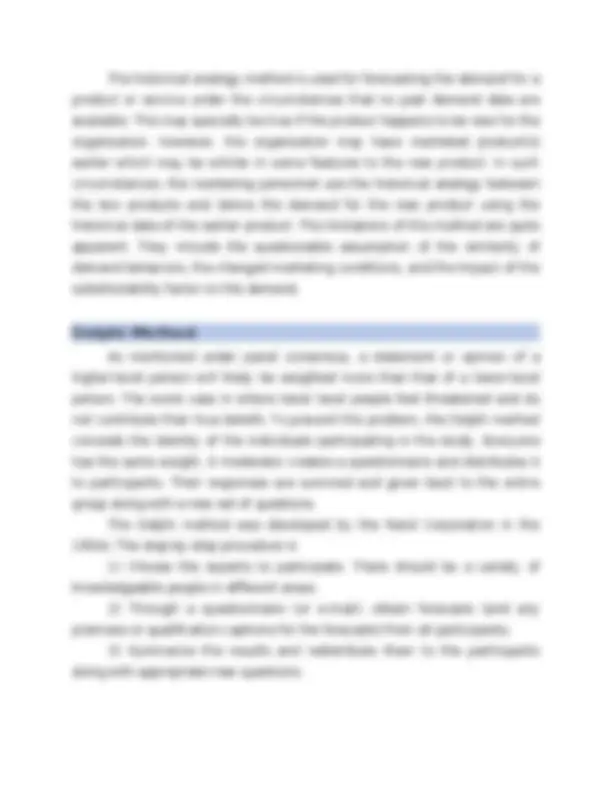
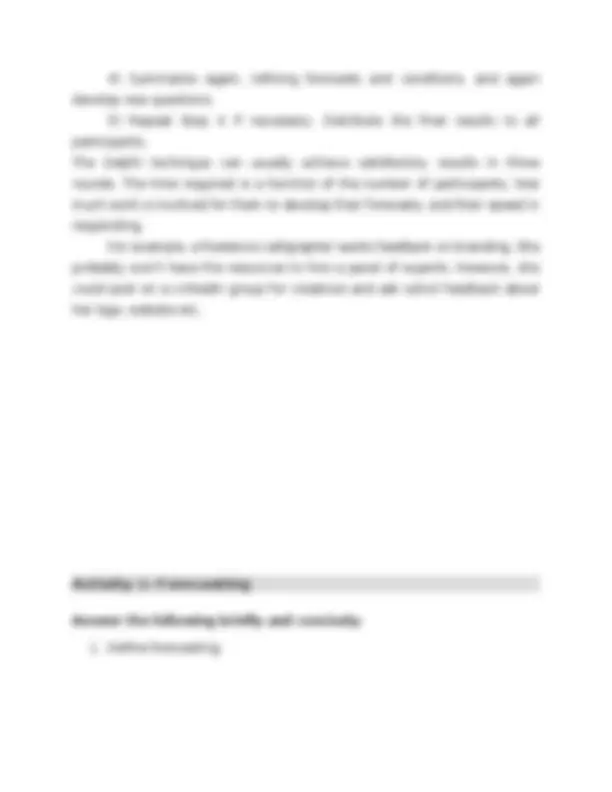
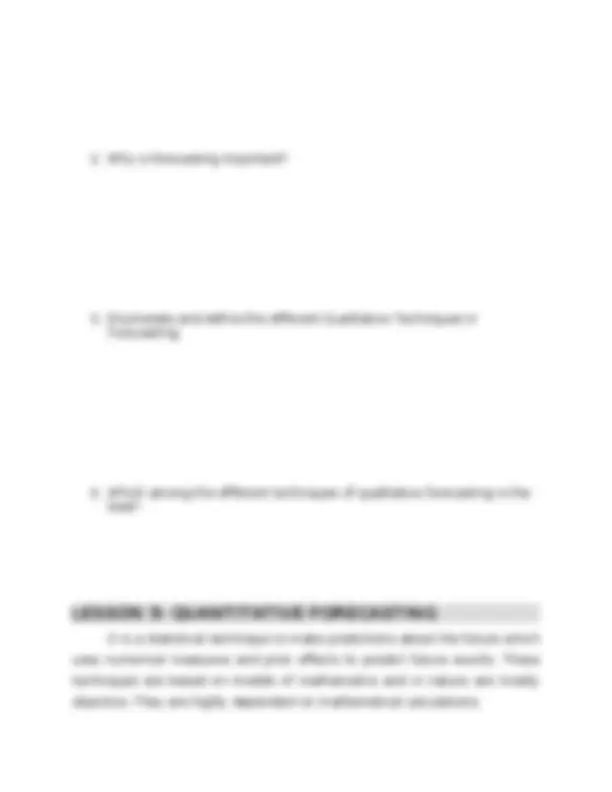
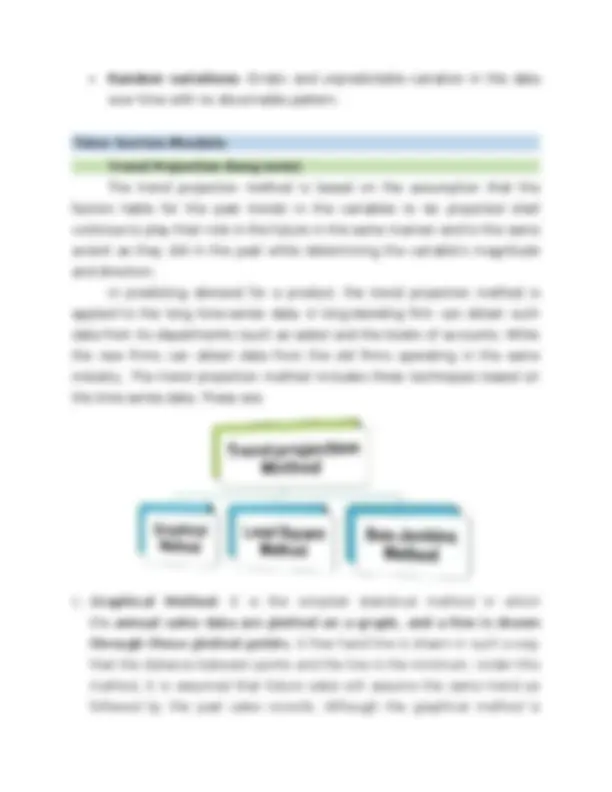
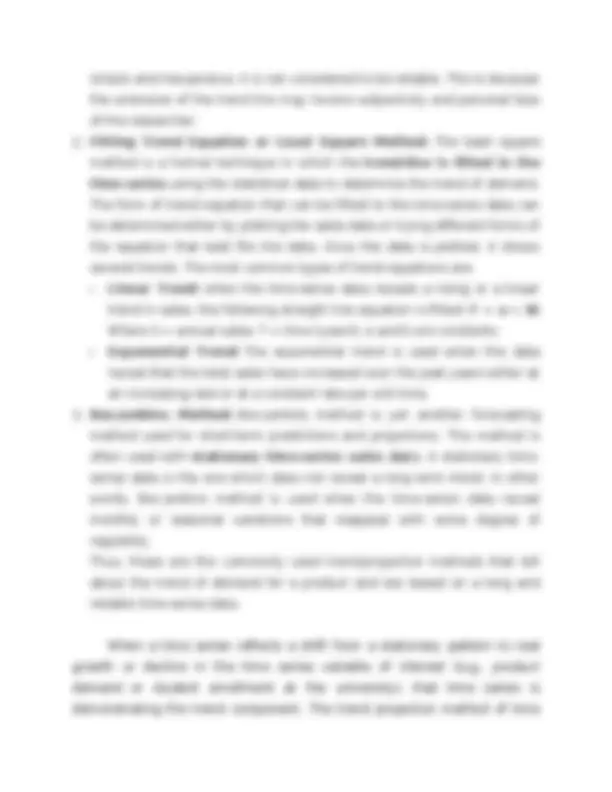
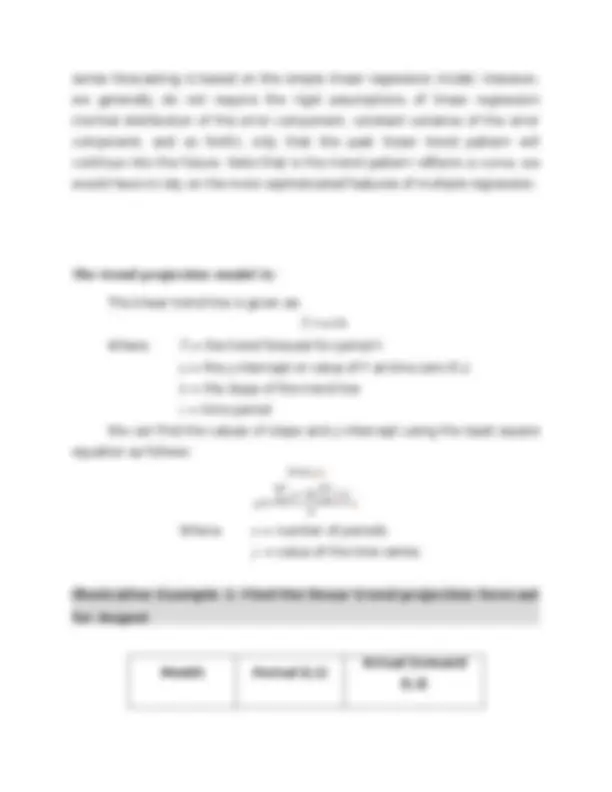
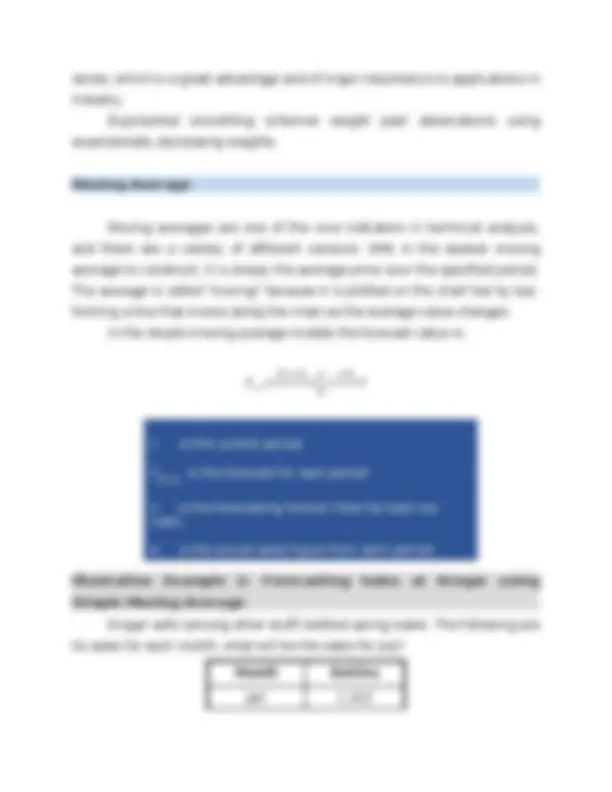
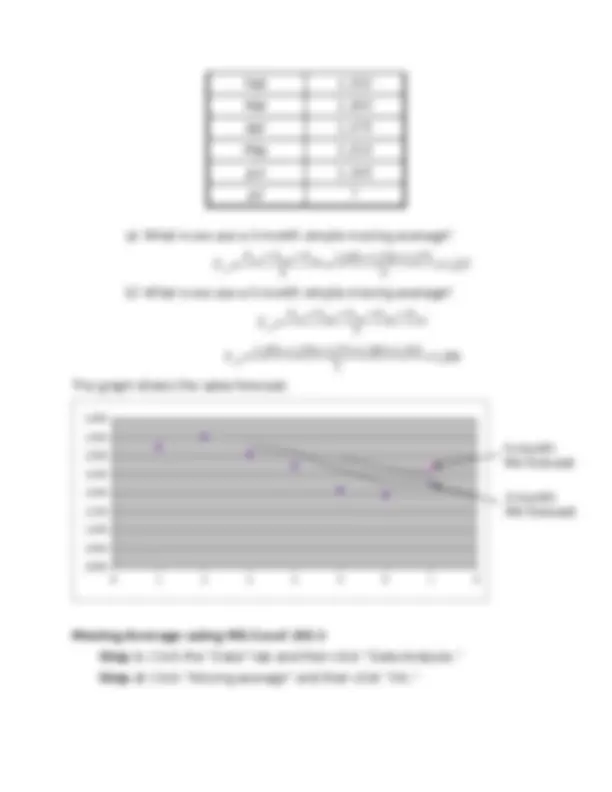
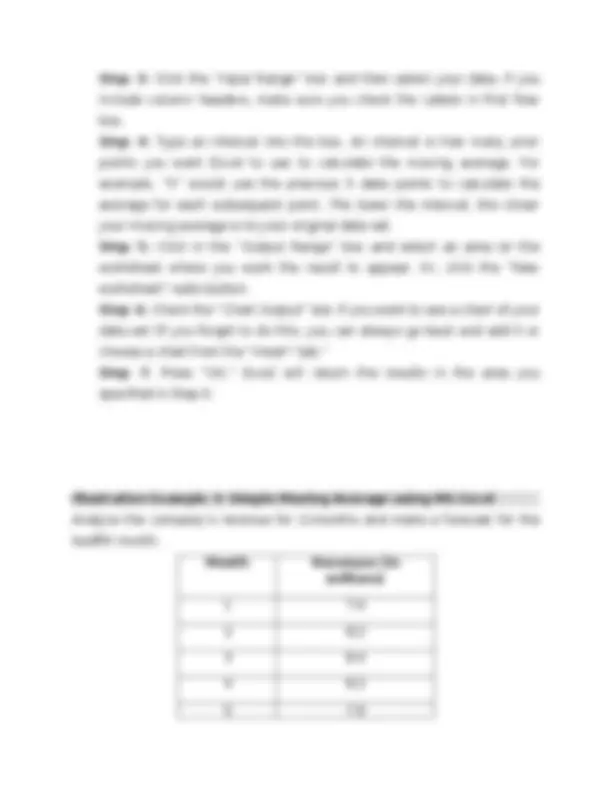
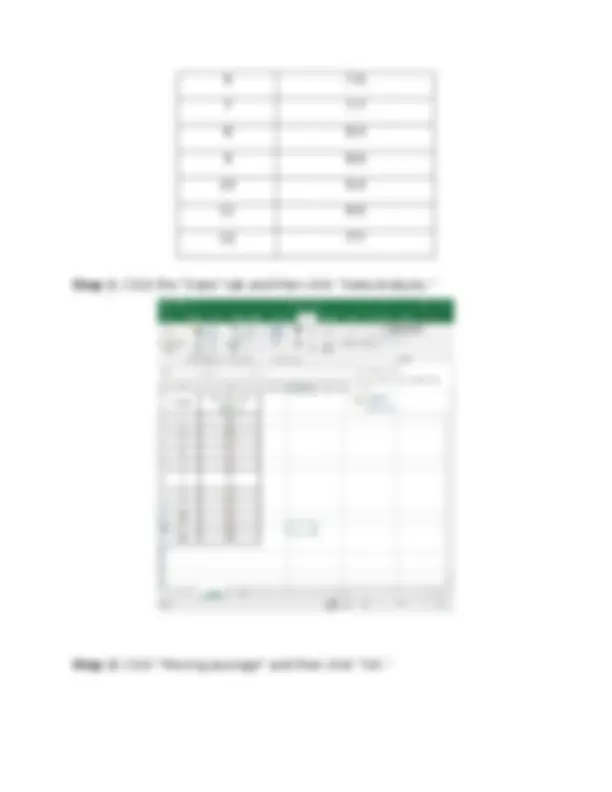
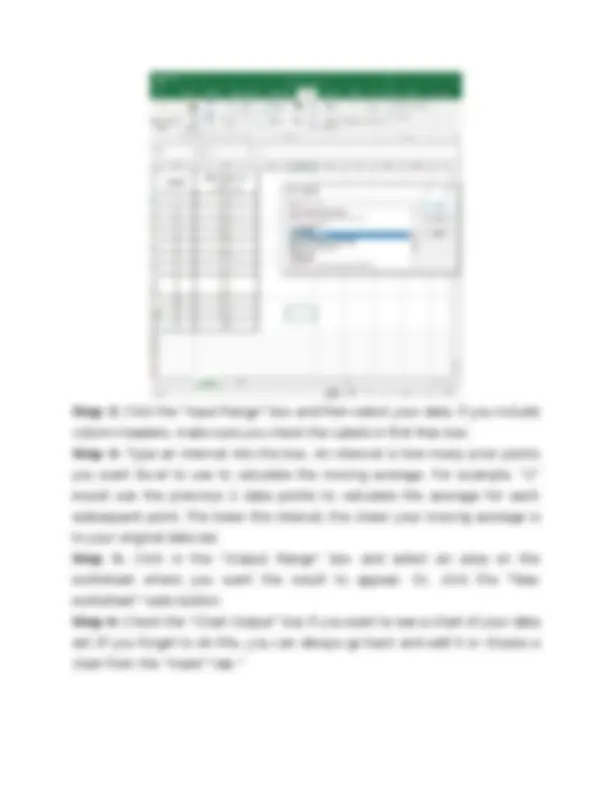
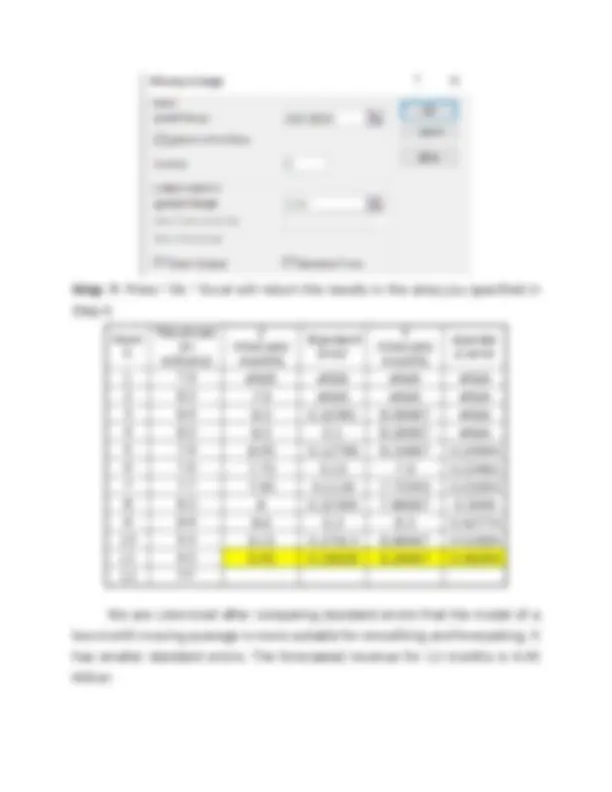
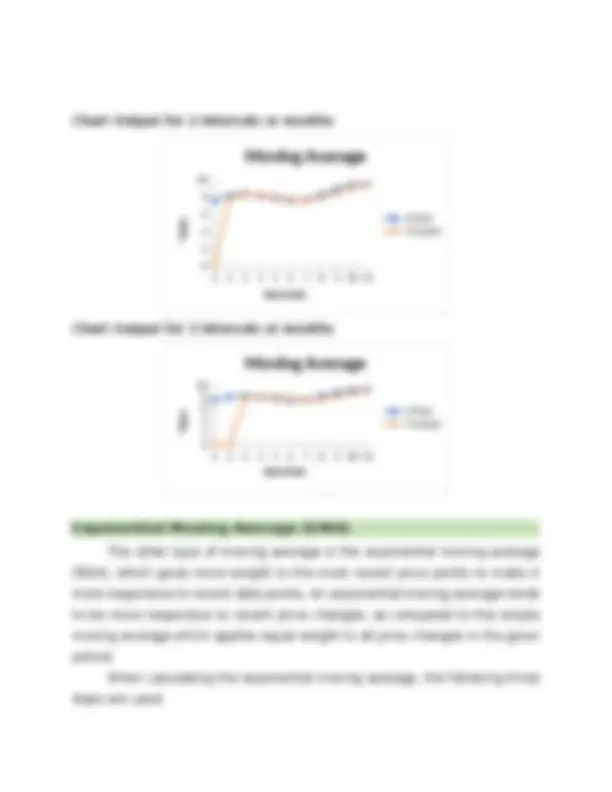
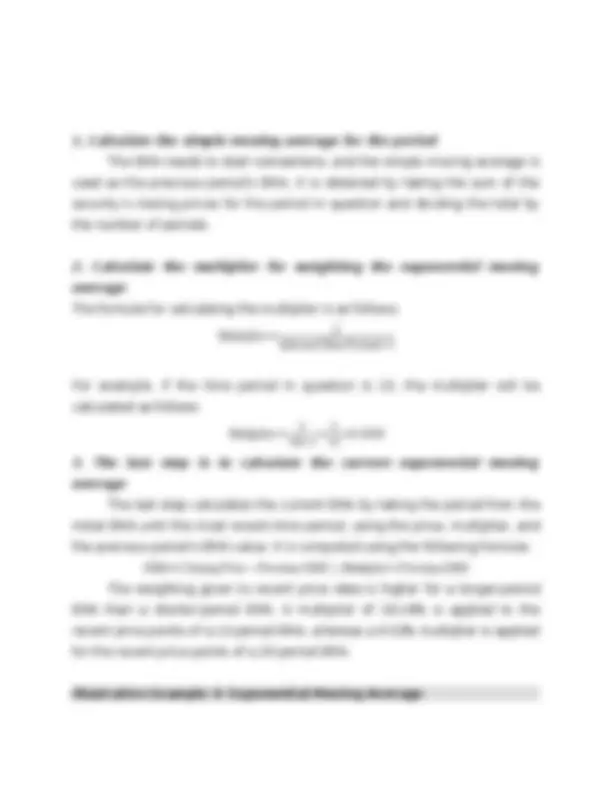
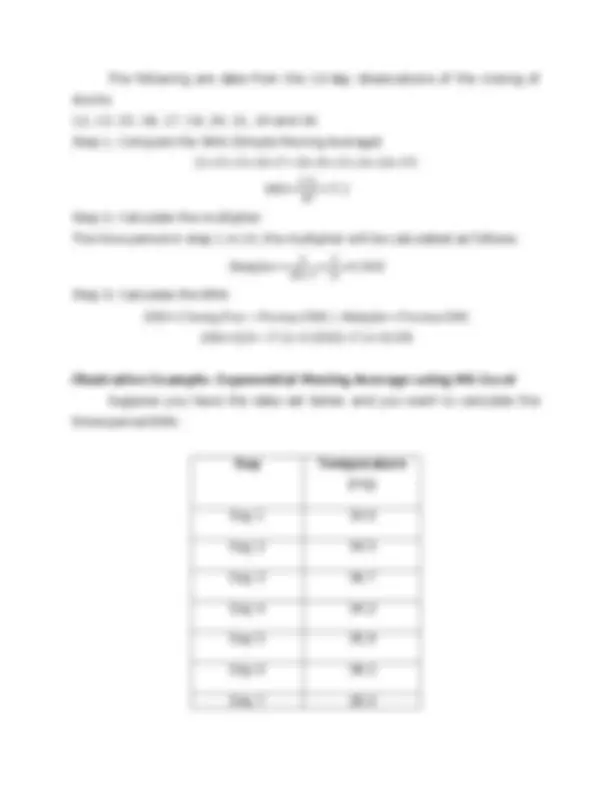
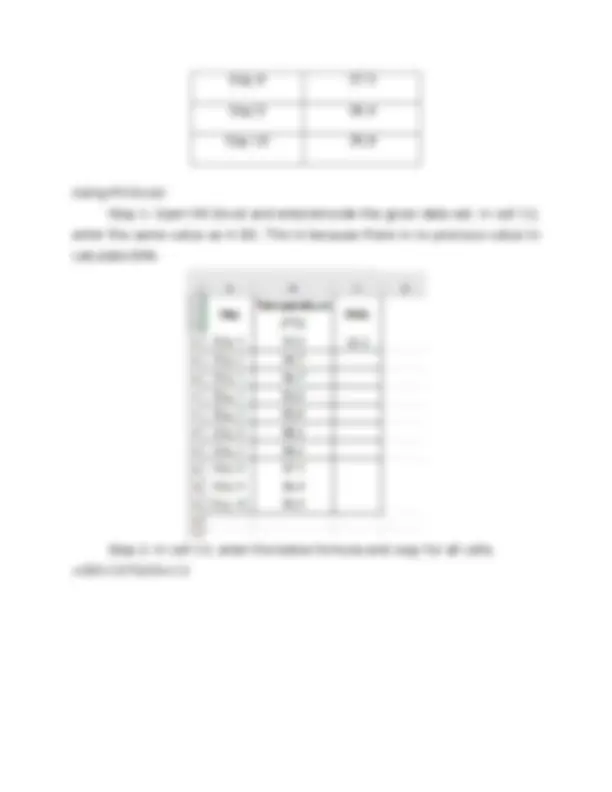
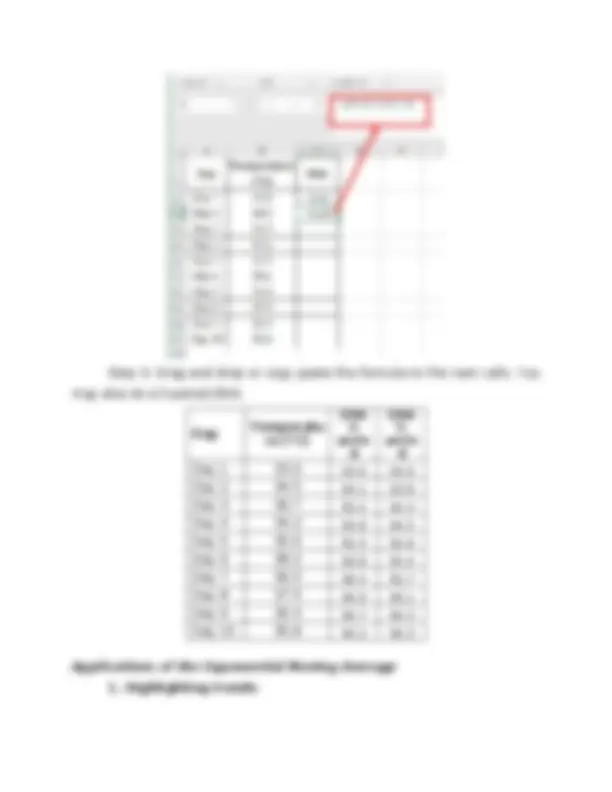
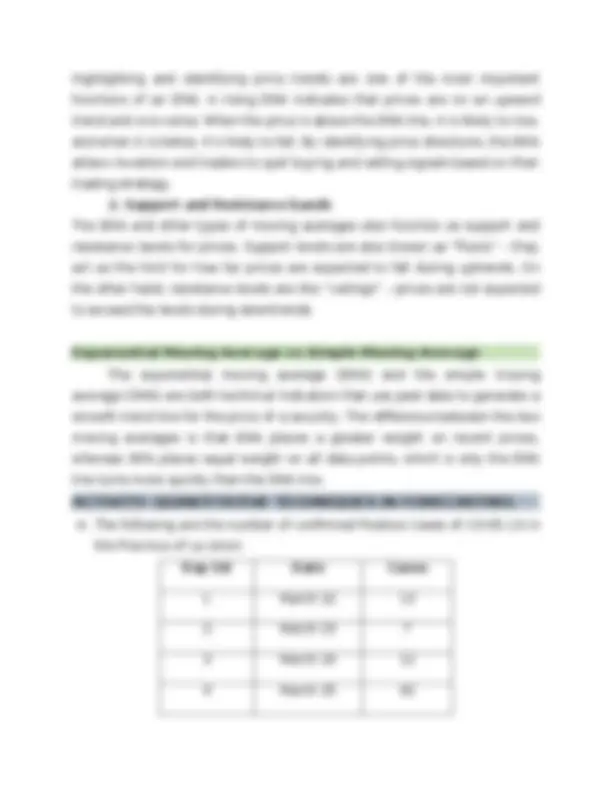
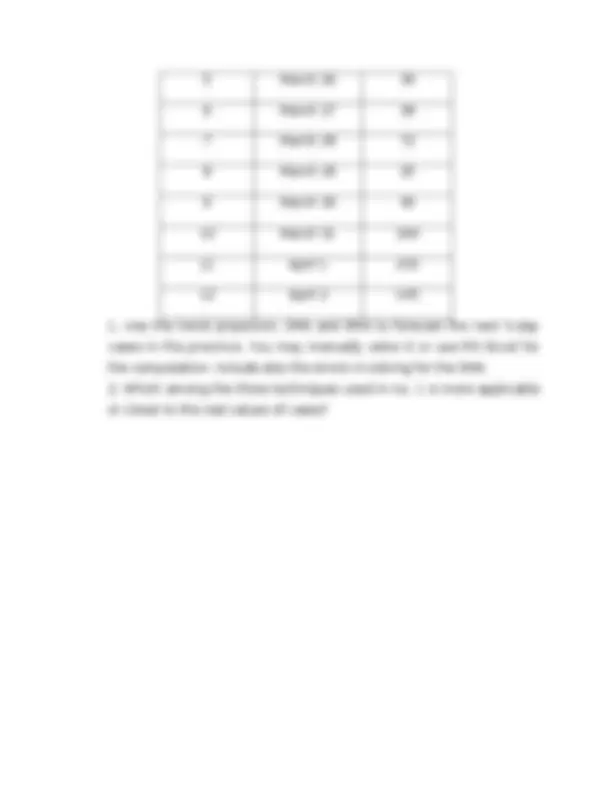


Study with the several resources on Docsity

Earn points by helping other students or get them with a premium plan


Prepare for your exams
Study with the several resources on Docsity

Earn points to download
Earn points by helping other students or get them with a premium plan
Community
Ask the community for help and clear up your study doubts
Discover the best universities in your country according to Docsity users
Free resources
Download our free guides on studying techniques, anxiety management strategies, and thesis advice from Docsity tutors
Learn about forecasting and forecasting methods in statistic world.
Typology: Lecture notes
1 / 30

This page cannot be seen from the preview
Don't miss anything!























Lesson 1: Forecasting
Lesson 2: Qualitative Techniques
Lesson 3: Quantitative Techniques
3.1 Straight-Line Method
3.2 Moving Average
Forecasting is a process of estimating a future event by casting
forward past data. The past data are systematically combined in a
predetermined way to obtain the estimate of the future. In business
applications, forecasting serves as a starting point of major decisions
in finance, marketing, productions, and purchasing.
This module contains what forecasting is, its importance, the
qualitative and quantitative forecasting and its types or models.
At the end of this module, you will be able to:
A forecast is an estimate of a future event achieved by systematically
combining and casting forward in predetermined way data about the past. It
is simply a statement about the future. It is clear that we must distinguish
between forecast per se and good forecasts. Good forecast can be quite
valuable and would be worth a great deal. Long-run planning decisions
require consideration of many factors: general economic conditions, industry
trends, probable competitor’s actions, overall political climate, and so on.
Forecasts are possible only when a history of data exists.
In general, when business people speak of forecasts, they usually
mean some combination of both forecasting and prediction. Forecasts are
often classified according to time period and use. In general, short-term (up
to one year) forecasts guide current operations. Medium-term (one to three
years) and long-term (over five years) forecasts support strategic and
competitive decisions.
Bear in mind that a perfect forecast is usually impossible. Too many
factors in the business environment cannot be predicted with certainty.
Therefore, rather than search for the perfect forecast, it is far more
important to establish the practice of continual review of forecasts and to
learn to live with inaccurate forecasts. This is not to say that we should not
try to improve the forecasting model or methodology, but that we should try
to find and use the best forecasting method available, within reason.
Because forecasts deal with past data, our forecasts will be less reliable the
further into the future we predict. That means forecast accuracy decreases
as time horizon increases. The accuracy of the forecast and its costs are
interrelated. In general, the higher the need for accuracy translates to higher
costs of developing forecasting models. So how much money and manpower
is budgeted for forecasting? What possible benefits are accrued from
accrued from accurate forecasting? What are possible cost of inaccurate
forecasting? The best forecast are not necessarily the most accurate or the
Businessmen use various qualitative and quantitative demand forecasting
techniques to predict future demand for products and accordingly take
business decisions.
Forecasts are needed for marketing, production, purchasing,
manpower, and financial planning. Further, top management needs forecasts
for planning and implementing long-term strategic objectives and planning
for capital expenditures.
The following are the general steps in forecasting:
1) Identify the general need
2) Select the Period (Time Horizon) of Forecast
3) Select Forecast Model to be used : For this, knowledge of
various forecasting models, in which situations these are applicable, how
reliable each one of them is; what type of data is required. On these
considerations; one or more models can be selected.
4) Data Collection: With reference to various indicators identified-
collect data from various appropriate sources-data which is compatible with
the model(s) selected in step(3). Data should also go back that much in past,
which meets the requirements of the model.
5) Prepare forecast: Apply the model using the data collected and
calculate the value of the forecast.
6) Evaluate: The forecast obtained through any of the model should
not be used, as it is, blindly. It should be evaluated in terms of ‘confidence
interval’ – usually all good forecast models have methods of calculating
upper value and the lower value within which the given forecast is expected
to remain with certain specified level of probability. It can also be evaluated
from logical point of view whether the value obtained is logically feasible? It
can also be evaluated against some related variable or phenomenon. Thus, it
is possible, sometimes advisable to modify the statistically forecasted’ value
based on evaluation.
Lesson 2: Qualitative Techniques in Forecasting
Qualitative forecasting is an estimation methodology that uses expert
judgment, rather than numerical analysis. This type of forecasting relies
upon the knowledge of highly experienced employees and consultants to
provide insights into future outcomes. This approach is substantially different
from quantitative forecasting, where historical data is compiled and analyzed
to discern future trends. Qualitative forecasting is most useful in situations
where it is suspected that future results will depart markedly from results in
prior periods, and which therefore cannot be predicted by quantitative
means.
Another situation in which qualitative forecasting can be useful is in
the assimilation of large amounts of narrowly-focused local data to discern
trends that a more quantitative analysis might not find.
This approach also works well when a course of action must be derived
from inadequate data.
The results produced by qualitative forecasting can be biased, for the
following reasons:
historical events in extrapolating future trends.
Market research ranges from consumer surveys to interviews to panels
which all provide subjective, qualitative information. Many consumer product
companies use market research as their primary forecasting tool.
For example, a personal trainer may want a better idea of what people
look for in a trainer. There are plenty of websites to mine public opinion such
as Quora, Reddit and Facebook groups. For example, a trainer could jump on
Reddit and analyze any number of subreddits like /r/fitness, /r/bodybuilding
or /r/running to get niche (and often candid) information or post questions
himself. Once he’s familiar with the group, he can even post a link to a
custom survey.
Panel Consensus
In a panel consensus, the idea that two heads are better than one is
extrapolated to the idea that a panel of people from a variety of positions
can develop a more reliable forecast than a narrower group. Panel forecasts
are developed through open meetings with free exchange of ideas form all
levels of management and individuals.
The difficulty with this open style is that lower employee levels are
intimidated by higher levels of management.
For example, a salesperson in a particular product line may have a
good estimate of future product demand but may not speak up to refute a
much different estimate given by the vice president of marketing. The Delphi
technique (which we discuss shortly) was developed to try to correct this
impairment to free exchange.
When decisions in forecasting are at a broader, higher level (as when
introducing a new product line or concerning strategic product decisions
such as new marketing areas) the term executive judgment is generally
used. The term is self-explanatory: a higher level of management is involved.
Historical Analogy
The historical analogy method is used for forecasting the demand for a
product or service under the circumstances that no past demand data are
available. This may specially be true if the product happens to be new for the
organization. However, the organization may have marketed product(s)
earlier which may be similar in some features to the new product. In such
circumstances, the marketing personnel use the historical analogy between
the two products and derive the demand for the new product using the
historical data of the earlier product. The limitations of this method are quite
apparent. They include the questionable assumption of the similarity of
demand behaviors, the changed marketing conditions, and the impact of the
substitutability factor on the demand.
Delphi Method
As mentioned under panel consensus, a statement or opinion of a
higher-level person will likely be weighted more than that of a lower-level
person. The worst case in where lower level people feel threatened and do
not contribute their true beliefs. To prevent this problem, the Delphi method
conceals the identity of the individuals participating in the study. Everyone
has the same weight. A moderator creates a questionnaire and distributes it
to participants. Their responses are summed and given back to the entire
group along with a new set of questions.
The Delphi method was developed by the Rand Corporation in the
1950s. The step-by-step procedure is
knowledgeable people in different areas.
premises or qualification captions for the forecasts) from all participants.
along with appropriate new questions.
Forecasting.
best?
It is a statistical technique to make predictions about the future which
uses numerical measures and prior effects to predict future events. These
techniques are based on models of mathematics and in nature are mostly
objective. They are highly dependent on mathematical calculations.
There are many different quantitative models to choose from and
selecting the most beneficial strategy will vary depending on the company's
situation and goals.
The main advantage of utilizing quantitative techniques is based on
available hard data. This ensures forecasting results are as objective as
possible, as the importance is placed on numerical information and
quantifiable past performance rather than the opinions of industry experts or
customers.
The more historical sales data a company has to work with, the more
reliable the forecasting results will be, as they'll have a better chance of
producing accurate seasonal averages throughout the years.
For example, a business could accurately predict how much a
particular product is likely to sell within a specific period of time, purely
based on past performance and previous sales information.
This method of forecasting requires more than just a few quick glances at
charts and other past data; some approaches may require more complex
calculations than others.
There are many techniques or models in Quantitative forecasting. Here
are the main classes of quantitative models used by companies to forecast.
I. Time Series Models
i. Trend Projection (long term)
ii. Decomposition methods (intermediate term)
iii. Smoothing methods (short term)
a. Exponential smoothing
b. Naïve forecasting
II. Causal Models
Random variations: Erratic and unpredictable variation in the data
over time with no discernable pattern.
Trend Projection (long term)
The trend projection method is based on the assumption that the
factors liable for the past trends in the variables to be projected shall
continue to play their role in the future in the same manner and to the same
extent as they did in the past while determining the variable’s magnitude
and direction.
In predicting demand for a product, the trend projection method is
applied to the long time-series data. A long-standing firm can obtain such
data from its departments (such as sales) and the books of accounts. While
the new firms can obtain data from the old firms operating in the same
industry. The trend projection method includes three techniques based on
the time-series data. These are:
the annual sales data are plotted on a graph, and a line is drawn
through these plotted points. A free hand line is drawn in such a way
that the distance between points and the line is the minimum. Under this
method, it is assumed that future sales will assume the same trend as
followed by the past sales records. Although the graphical method is
simple and inexpensive, it is not considered to be reliable. This is because
the extension of the trend line may involve subjectivity and personal bias
of the researcher.
method is a formal technique in which the trend-line is fitted in the
time-series using the statistical data to determine the trend of demand.
The form of trend equation that can be fitted to the time-series data can
be determined either by plotting the sales data or trying different forms of
the equation that best fits the data. Once the data is plotted, it shows
several trends. The most common types of trend equations are:
Linear Trend: when the time-series data reveals a rising or a linear
trend in sales, the following straight line equation is fitted: F = a + bt
Where S = annual sales; T = time (years); a and b are constants.
Exponential Trend: The exponential trend is used when the data
reveal that the total sales have increased over the past years either at
an increasing rate or at a constant rate per unit time.
method used for short-term predictions and projections. This method is
often used with stationary time-series sales dat a. A stationary time-
series data is the one which does not reveal a long term trend. In other
words, Box-Jenkins method is used when the time-series data reveal
monthly or seasonal variations that reappear with some degree of
regularity.
Thus, these are the commonly used trend-projection methods that tell
about the trend of demand for a product and are based on a long and
reliable time-series data.
When a time series reflects a shift from a stationary pattern to real
growth or decline in the time series variable of interest (e.g., product
demand or student enrollment at the university), that time series is
demonstrating the trend component. The trend projection method of time
January 1 1000
February 2 1150
March 3 1200
April 4 1240
May 5 1300
June 6 1310
July 7 1350
August 8?
The output will be as follows:
Month Period (t)
Actual Demand
(y)
ty (^) t
2
January 1 1000 1000 1
February 2 1150 2300 4
March 3 1200 3600 9
April 4 1240 4960 16
May 5 1300 6500 25
June 6 1310 7860 36
July 7 1350 9450 49
∑t = 28 ∑ y = 8550 ∑ ty = (^35670) ∑t
2 = 140
b = n ¿ ¿
b =
2
a =
∑ y − b^ (∑ t ¿)
n
The slope = b = 52.5, the y-intercept = a = 1011.429.
So the linear trend equation is: Ft =1011.429+52.5^ t
To find the forecast for August, we plug in t=8 in the above equation as
follows:
t
Ft =1431.429= 1431
∴The demand forecast for themonth of August is 1431.
The linear trend equation is known as the Slope-Intercept Form in Algebra.
Exponential smoothing
Exponential smoothing was proposed in the late 1950s (Brown, 1959;
Holt, 1957; Winters, 1960), and has motivated some of the most successful
forecasting methods. Forecasts produced using exponential smoothing
methods are weighted averages of past observations, with the weights
decaying exponentially as the observations get older. In other words, the
more recent the observation the higher the associated weight. This
framework generates reliable forecasts quickly and for a wide range of time
Feb 1,
Mar 1,
Apr 1,
May 1,
Jun 1,
Jul?
a) What is we use a 3-month simple moving average?
Jul
Jun
May
Apr
b) What is we use a 5-month simple moving average?
Jul
Jun
May
Apr
Mar
Feb
Jul
The graph shows the sales forecast:
0 1 2 3 4 5 6 7 8
1000
1050
1100
1150
1200
1250
1300
1350
1400
Moving Average using MS Excel 2013
Step 1: Click the “Data” tab and then click “Data Analysis.”
Step 2: Click “Moving average” and then click “OK.”
3-month
MA forecast
5-month
MA forecast
Step 3: Click the “Input Range” box and then select your data. If you
include column headers, make sure you check the Labels in first Row
box.
Step 4: Type an interval into the box. An interval is how many prior
points you want Excel to use to calculate the moving average. For
example, “5” would use the previous 5 data points to calculate the
average for each subsequent point. The lower the interval, the closer
your moving average is to your original data set.
Step 5: Click in the “Output Range” box and select an area on the
worksheet where you want the result to appear. Or, click the “New
worksheet” radio button.
Step 6: Check the “Chart Output” box if you want to see a chart of your
data set (if you forget to do this, you can always go back and add it or
choose a chart from the “Insert” tab.”
Step 7: Press “OK.” Excel will return the results in the area you
specified in Step 6.
Illustrative Example 3: Simple Moving Average using MS Excel
Analyze the company’s revenue for 11months and make a forecast for the
twelfth month.
Month Revenues (in
millions)